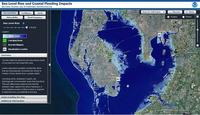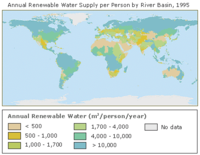-
Melting Arctic sea ice increases summer rainfall in northwest Europe
A new study offers an explanation for the extraordinary run of wet summers experienced by Britain and northwest Europe between 2007 and 2012. The study found that loss of Arctic sea ice shifts the jet stream further south than normal resulting in increased rain during the summer in northwest Europe. The annual average extent of Arctic sea ice is currently declining at about half a million square kilometers per decade — equivalent to about twice the area of the United Kingdom.
-
-
Scientists: Shale oil and gas may not be U.S. energy salvation
After ten years of production, shale gas in the United States cannot be considered commercially viable, scientists say. They argue that while the use of hydraulic fracturing and horizontal drilling for “tight oil” is an important contributor to U.S. energy supply, it is not going to result in long-term sustainable production or allow the United States to become a net oil exporter.
-
-
Urban underground water can be used for sustainable energy
Vast energy sources are slumbering below big cities. Sustainable energies for heating in winter and cooling in summer may be extracted from heated groundwater aquifers. Researchers developed an analytical heat flux model and found that increasing heat in the underground is mainly caused by an increase in surface temperatures and heat release from buildings.
-
-
Russia to build floating nuclear power plants

Global warming is opening the Arctic Ocean to shipping – and causing the rapid melting of Arctic ice. Russia says that ship-based nuclear power plants would allow it to provide power to remote cities in Siberia, and provide power to oil and gas drilling operations in the Arctic (about 30 percent of the world’s unclaimed natural gas is in the Arctic, and about, 60 percent of that unclaimed natural gas is in the Russian Arctic). Experts worry about the ability of ship-based nuclear reactor to withstand extreme weather events, or terrorist attacks. The U.S. Army deployed its own floating nuclear reactor – the Sturgis – in the Panama Canal Zone from 1968 to 1976.
-
-
NIST seeks public comments on updated smart-grid cybersecurity guidelines
The National Institute of Standards and Technology (NIST) is requesting public comments on the first revision to its guidelines for secure implementation of “smart grid” technology. The draft document, NIST Interagency Report (IR) 7628 Revision 1: Guidelines for Smart Grid Cybersecurity, is the first update to NISTIR 7628 since its initial publication in September 2010.
-
-
Where should U.S. radioactive waste be buried?
In the United States, about 70,000 metric tons of spent commercial nuclear fuel are located at more than seventy sites in thirty-five states. Shales and other clay-rich (argillaceous) rocks have never been seriously considered for holding America’s spent nuclear fuel, but it is different overseas. France, Switzerland, and Belgium are planning to put waste in tunnels mined out of shale formations, and Canada, Japan, and the United Kingdom are evaluating the idea.
-
-
Nuclear fuel withstands accident conditions’ high-temperature

A safer and more efficient nuclear fuel is on the horizon. A team of researchers have reached a new milestone with tristructural-isotropic (TRISO) fuel, showing that this fourth-generation reactor fuel might be even more robust than previously thought. Byproducts of the fission process have the potential to escape the fuel, especially at very high temperatures. Controlled, high-temperature testing of irradiated TRISO) fuel demonstrated that fission product release remains relatively low at high temperatures postulated to occur in accidents and beyond.
-
-
Sharp increase in radioactive water leaks at Fukushima
Tokyo Electric Power(TEPCO) has reported a rise in groundwater radiation levels, saying a tank at the firm’s Fukushima plant leaked 300 metric tons of toxic water in August 2013. Water samples from wells, taken in mid-October, show a record-high concentration of beta-ray emitting substances, and a sharp increase in the presence of radioactive tritium. Japanese prime ministerShinzo Abe, in a tacit admission that Japan cannot effectively handle the continuing radiation leaks from the stricken plant, said Japan would be interested in receiving foreign help to contain widening radioactive water leaks at Fukushima.
-
-
New method to help coastal communities adapt to sea-level rise

Future sea-level rise seems inevitable, although the rates and geographical patterns of change remain uncertain. Given the large and growing populations and economic activity in coastal zones, as well as the importance of coastal ecosystems, the potential impacts of sea-level change are far-reaching. Current methods to assess the potential impact of sea-level rise have varied significantly and hindered the development of useful scenarios and, in turn, suitable adaption policies and planning.
-
-
Preventing a Bhopal-like catastrophe in New Jersey
New Jersey is home to ninety facilities which produce and store large quantities of highly toxic chemicals. A superstorm or terrorist attack could doom millions of people around southern New Jersey and eastern Pennsylvania to a Bhopal, 1984-like fate if either of these facilities and their storage tanks were affected.Typically, in the aftermath of major disasters, a blue ribbon panel is created to review preventative measures that could have been taken before the disaster. Security experts say that there is no need to wait for a post-disaster blue ribbon panel investigation to know what sensible safety measures should be implemented now.
-
-
Burping for power: Tapping cow burps for natural gas
Scientists in Argentina have developed a method to transform the gas created by cows’ digestive systems into fuel. The technique channels the digestive gases from bovine stomach cavities through a tube and into a tank, where the gases, called eruptos (burps) in Spanish, are processed to separate methane from other gases such as carbon dioxide.
-
-
NIST releases Preliminary Cybersecurity Framework
The National Institute of Standards and Technology (NIST) on Tuesday released its Preliminary Cybersecurity Framework to help critical infrastructure owners and operators reduce cybersecurity risks in industries such as power generation, transportation, and telecommunications. In the coming days, NIST will open a 45-day public comment period on the Preliminary Framework and plans to release the official framework in February 2014.
-
-
$32 million NSF grants for improving prediction of, response to natural disasters
With Sandy’s one-year anniversary – 29 October – next week, how do scientists better predict and respond to natural hazards such as hurricanes, tornadoes, floods, earthquakes, tsunamis, and wildfires? To find answers, the National Science Foundation (NSF) recently awarded twelve new research grants totaling $32 million. The awards will advance understanding of natural hazards and of technological hazards linked with natural phenomena, as scientists study ways of predicting and responding to hurricanes, tornadoes, floods, earthquakes, tsunamis, wildfires.
-
-
More than 500 million people could face increasing water scarcity

Both freshwater availability for many millions of people and the stability of ecosystems such as the Siberian tundra or Indian grasslands are put at risk by climate change. Even if global warming is limited to 2 degrees above pre-industrial levels, 500 million people could be subject to increased water scarcity.
-
-
Cyber Grand Challenge for automated network security-correcting systems
What if computers had a “check engine” light that could indicate new, novel security problems? What if computers could go one step further and heal security problems before they happen? To find out, the Defense Advanced Research Projects Agency (DARPA) intends to hold the Cyber Grand Challenge (CGC) — the first-ever tournament for fully automatic network defense systems. The Challenge will see teams creating automated systems that would compete against each other to evaluate software, test for vulnerabilities, generate security patches, and apply them to protected computers on a network. The winning team in the CGC finals would receive a cash prize of $2 million, with second place earning $1 million and third place taking home $750,000.
-
More headlines
The long view
Water Wars: A Historic Agreement Between Mexico and US Is Ramping Up Border Tension
As climate change drives rising temperatures and changes in rainfall, Mexico and the US are in the middle of a conflict over water, putting an additional strain on their relationship. Partly due to constant droughts, Mexico has struggled to maintain its water deliveries for much of the last 25 years, deliveries to which it is obligated by a 1944 water-sharing agreement between the two countries.
Trump Is Fast-Tracking New Coal Mines — Even When They Don’t Make Economic Sense
In Appalachian Tennessee, mines shut down and couldn’t pay their debts. Now a new one is opening under the guise of an “energy emergency.”
Smaller Nuclear Reactors Spark Renewed Interest in a Once-Shunned Energy Source
In the past two years, half the states have taken action to promote nuclear power, from creating nuclear task forces to integrating nuclear into long-term energy plans.
Keeping the Lights on with Nuclear Waste: Radiochemistry Transforms Nuclear Waste into Strategic Materials
How UNLV radiochemistry is pioneering the future of energy in the Southwest by salvaging strategic materials from nuclear dumps –and making it safe.
Model Predicts Long-Term Effects of Nuclear Waste on Underground Disposal Systems
The simulations matched results from an underground lab experiment in Switzerland, suggesting modeling could be used to validate the safety of nuclear disposal sites.
